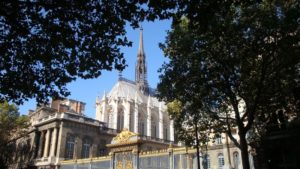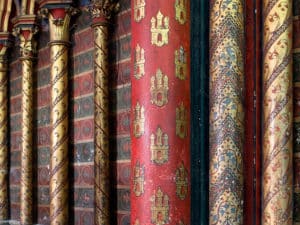Sainte-Chapelle: its origin is linked to King Saint Louis
The Sainte-Chapelle, also known as the Sainte-Chapelle du Palais, is a palatine chapel (whose use was intended for that of the sovereign). Il is located near the Palais de Justice, the Conciergerie and the Tour de l'Horloge. It was built on the Ile de la Cité, in Paris, at the request of Louis IX (Saint Louis, canonized in 1297, twenty-seven years after his death) in the heart of his Parisian residence, the Palais de la Cité. La Sainte Chapelle was to house the Holy Crown of Thorns, a piece of the True Cross, and various other relics of the Passion that he had acquired from 1239 onwards. It is the first building of the Holy Chapel, designed as a vast, almost entirely glazed shrine, and is distinguished by the elegance and boldness of its architecture, which is manifested in the significant elevation and almost total removal of the walls at the windows of the upper chapel.
Acquisition of the relics deposited in the Sainte Chapelle
During the siege of Constantinople in 1204, Baldwin VI of Hainaut plundered everything in Boucoléon's palace, including the True Cross and the Holy Crown. In 1237, the last Latin emperor of Constantinople, Baldwin II of Courtenay, arrived in France as part of an European voyage to finance the defense of Constantinople against the Bulgarians. Baudouin pawns the Holy Crown in September 1238 to Nicolo Quirino, a Venetian merchant close to the Doge of Venice. The merchant was not to become the owner of the relic unless Baudouin was unable to pay him back within four months.
Saint Louis is very interested in buying the Holy Crown. After a series of talks to verify the authenticity of the relic, he acquires the Holy Crown for 135,000 tournament pounds, more than half of the annual income of his royal estate. Under the guidance of Dominican preachers Jacques and André de Longjumeau, the relic took the road to France in 1239. On August 10, 1239, it made a solemn entrance at Villeneuve-l'Archevêque (Champagne area). On August 18, the Holy Crown enters Paris, in the presence of a large crowd of spectators and the entire clergy of the capital. During a large ceremony held the next day, the relic was deposited in the Saint-Nicolas chapel of the Palais de la Cité. Two years later, in 1241, the king pursued his ambition by acquiring a large piece of the Holy Cross and seven other relics of the Passion of Christ, including the Holy Blood and the Stone of the Sepulcher. The following year, pieces of the Holy Spear and the Holy Sponge were added to the Holy Collection.
A roof to match the veneration of the relics
With the acquisition of this collection of relics, Saint Louis decided to build a chapel conceived as a real shrine for the veneration of the relics. The new building took place in the Palais de la Cité, Saint Louis' main place of residence, and replaced the former Saint Nicholas Chapel, which was then destroyed.
Construction of the Sainte-Chapelle (1241 - 1248)
Although it was built in only seven years, there are no construction defects and the decoration has not been neglected. In particular, it makes use of sculpture, painting, and stained-glass art: it is its immense original historiated stained-glass windows that today make the Sainte-Chapelle's wealth, as it was deprived of its relics during the French Revolution, and thus lost its main original raison d'être.
Classified as a Historical Monument (1862) one year before the completion of its restoration, which is one of the most successful of its time. It is also listed as a World Heritage Site (1991).
Design of the Holy Chapel
This masterpiece of radiant Gothic architecture responds to a plan of great simplicity without collaterals, nor transept, nor ambulatory, which is one of the two main characteristics of the Saintes-Chapelles. The other one is a single-level elevation, without large arcades, which results from the absence of collaterals, nor triforium. Regularly oriented, the chapel has two levels, giving two superimposed chapels, known as the low chapel and the high chapel.
Low chapel
The dark atmosphere of the lower chapel and its proportions evoke a crypt, but the delicacy of the supports contrasts with this impression, and the decoration shows the same elegance as in the upper chapel.
High chapel
The multitude and intensity of the colors most mark the atmosphere of the high chapel, as well as its elegance and height, which is almost twice its width. Although luminous, the high chapel is generally not flooded with light, as the 13th-century stained glass windows are semi-opaque. The elevation is much simpler and more clearly structured than in the lower chapel, and the entire architecture of the Sainte-Chapelle was designed to allow for this unique large space encumbered by no free pillars. It highlights the verticality of the almost entirely hollowed-out walls.
The building
The Sainte-Chapelle is 36.0 m long, 17.0 m wide, and 42.5 m high without the boom. The spire reaches a height of 33.25 m, placing its top at 75.75 m above ground level. Inside, the two chapels are 33.0 m long and 10.7 m wide. The vaulted height of the lower chapel is only 6.6 m, while the upper chapel is 20.5 m high. In its interior area, the Sainte-Chapelle is comparable to a village church, but the width of the single vessel is comparable to the nave of the cathedral of Laon, and its height to the first Gothic cathedrals.
The Revolution, the Sainte-Chapelle, and the Relics
The Sainte-Chapelle was closed to worship around 1790 - and remains so to this day. It was then emptied of all its contents and turned into the "seat of the Club de la Sainte-Chapelle". In 1797, it was transformed into the archives of the nearby courthouse, and the expansion of the courthouse threatened its very existence. Its rescue was decided in 1836 under pressure from public opinion, and its restoration was launched a year later and lasted twenty-six years.
Contrary to what can be observed elsewhere, the relics themselves are not desecrated during the French Révolution of 1789, for because of their antiquity, they impose respect even on non-believing revolutionaries. But they have been melted, lost, or scattered. While the great shrine was melted down in 1791, and the reliquaries in 1791 and 1793 especially, always with the aim of recovering precious metals, the relics were entrusted to Jean-Baptiste Gobel, constitutional bishop. They are transported to Saint-Denis, and it is there that many of them disappear in conditions not yet elucidated. The Holy Crown was deposited in the Cabinet des Antiques in 1793, and given to Cardinal Jean-Baptiste de Belloy in 1804. Today it is kept in the treasury of Notre-Dame de Paris. The cameo of the Triumph of Germanicus and the bust of Constantine are sent to the Medal Cabinet, and the missal and three evangelicals with gold binding plates to the Manuscript Department of the National Library of France. The reliquary of the "Stone of the Sepulchre" and the Ivory Virgin are kept in the Department of Works of Art at the Louvre Museum; and the reliquary of Saint Maxien, Saint Lucien, and Saint Junien at the Cluny Museum.










Add a review